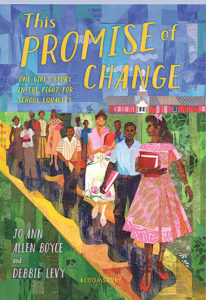This Promise of Change: One Girl’s Story in the Fight for School Equality
Reviewed by Anna Carolyn McCormally
December 1, 2019
 By Jo Ann Allen Boyce and Debbie Levy. Bloomsbury Children’s Books, 2019. 320 pages. $17.99/hardcover; $12.99/paperback (available March 2020); $12.59/eBook. Recommended for ages 8–12.
By Jo Ann Allen Boyce and Debbie Levy. Bloomsbury Children’s Books, 2019. 320 pages. $17.99/hardcover; $12.99/paperback (available March 2020); $12.59/eBook. Recommended for ages 8–12.
This Promise of Change is a memoir in verse that offers an intimate account of school integration from the perspective of someone who lived it: Jo Ann Allen Boyce, one of a group of 12 Black students to enroll at Clinton High School in Clinton, Tenn., in 1956 following a court order to integrate. The form-free verse poetry with news clippings, interviews, and other primary sources interspersed throughout delivers both broad historical context as well as a personal story. It captures both the broad view of integration and the detail of what it felt like for one high school girl who simply wanted to go to school, make friends, and feel like she belonged in her town.
The story fits this form well. In addition to telling hard truths about the reality of integration (Thousands of people from neighboring towns came to Clinton to protest the Black students’ enrollment; the KKK stormed the hill leading to the neighborhood where Boyce and many of her classmates lived; the White minister who escorted them into school one day was beaten, nearly to death, by a mob of protestors.), it’s a story about Boyce coming to understand the depths of cruelty her White neighbors will go to in order to resist integration. It is a story about what racism, prejudice, and discrimination look like, how they function on the ground every day. In a poem titled “They’re Back (Monday, November 26),” set the Monday after Thanksgiving, she asks of the mob gathered to harass her and her friends on the way to school:
Over turkey and gravy
did they give thanks
and make plans to
give grief?
. . . . . . . .
Who gives thanks,
only to gather in school
shoving and sneering and spitting?
The moments of introspection offered by This Promise of Change are complex, touching on questions about racism and racial identity that are more complicated than Black and White. In a poem addressed to the White girls at Clinton High School who treat her at best coldly and at worst with cruelty, Boyce holds up her ancestors:
So my two great-great-grandmothers,
slaves,
had children with light complexions,
. . . . . . . .
white enough to pass for white,
which means that
in the branches of my family tree
there are ancestors
who are as white
as you.
The authors’ choice to juxtapose Boyce’s voice with primary sources means that many voices come together in this book to show many facets of one story, and the short length of the poems that make up each chapter creates organic opportunities to pause, reflect, and ask questions. This is what makes it an effective book for young readers: many things are laid out, and many questions asked, but few concrete answers are presented. Those are left for the reader to parse out.



Comments on Friendsjournal.org may be used in the Forum of the print magazine and may be edited for length and clarity.